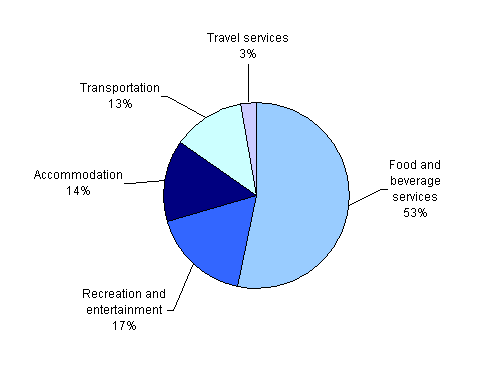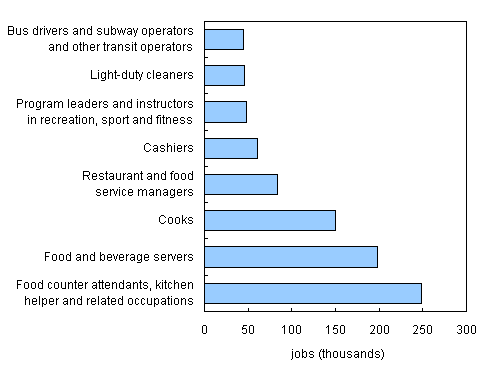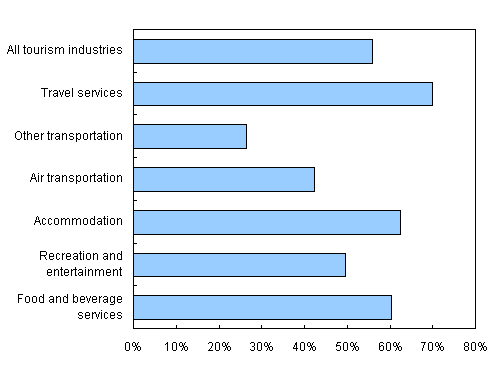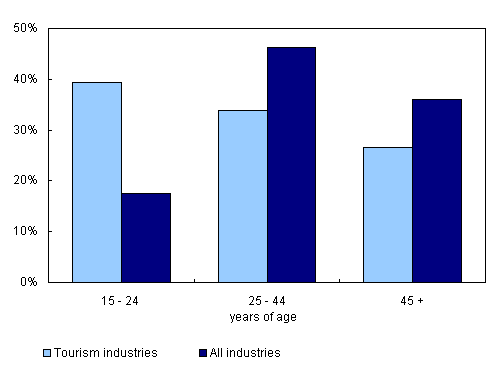Publications
Income and Expenditure Accounts Technical Series
Human Resources Module of the Tourism Satellite Account, 2007
Results
Archived Content
Information identified as archived is provided for reference, research or recordkeeping purposes. It is not subject to the Government of Canada Web Standards and has not been altered or updated since it was archived. Please "contact us" to request a format other than those available.
Jobs, hours and earnings in tourism industries
Tourism industry profiles
Occupations in tourism industries
Profile of employees in tourism industries
Because the Human Resources Module (HRM) contains such a large amount of data, the intent here is simply to highlight some findings and to illustrate some of the types of analyses the HRM can support. The analysis will focus on the year 2007 and changes from the previous year.
The year 2007 was characterized by strong growth in domestic tourism (+6.8%). Low unemployment and interest rates coupled with strong gains in disposable income contributed to solid gains in spending on tourism by Canadians. Economy-wide growth (as measured by GDP) was 2.5% in 2007, while tourism GDP grew 3.7%, as shown in Table 1. In addition, job growth in Canada was 2.1%, while the number of jobs in tourism industries was up 3.4%.
However, the year also registered continued weakness from international visitors. High gasoline prices, the stronger Canadian dollar, tighter passport regulations and a faltering U.S. economy contributed to weakness in visits from south of the border. Spending from international visitors was down 3.6% in 2007.
Jobs, hours and earnings in tourism industries
This section provides some broad comparisons with the overall economy in terms of the key variables of the HRM: jobs, hours worked and compensation.
Total compensation (wages and salaries, supplementary labour income, and income after expenses accruing to the self-employed) in the tourism industries was $46.9 billion in 2007, up 8.7% from the previous year. This was the fastest pace in ten years, driven by an increase in the number of jobs and higher hourly earnings. In comparison, labour compensation across all jobs in the economy was up 6.1% in 2007, a slower pace than in 2006.
Jobs in tourism industries totalled 1.7 million in 2007 (see Table 2) according to the HRM,1 including both full-time and part-time jobs, as well as employee jobs and jobs from self-employment. In other words, the tourism sector accounted for 9.6% of all jobs in the economy, about the same as in the previous ten years.
Part-time jobs were twice as prevalent as in the economy overall. Four out of ten jobs in tourism were part-time. Jobs from self-employment accounted for 6.9% of all jobs in tourism industries, but 9.4% of jobs in the Canadian economy overall.
The number of jobs in tourism grew 3.4% in 2007, more than twice the average 1.6% growth registered by tourism industries from 1997 to 2006. Some 55 thousand jobs were created in the tourism sector, of which 32 thousand were full-time. The majority were employee jobs (47 thousand).
A total of 2.6 billion hours was worked in tourism industries in 2007, accounting for 8.6% of the 29.7 billion hours worked economy-wide. This indicates an average work week of 29.8 hours in tourism, somewhat less than the economy-wide average of 33.3 hours. The shorter week reflects the higher proportion of part-time jobs found in tourism industries (40%) as compared to the economy overall (20%).
The average compensation per job in tourism was $18.33 per hour in 2007, up 5.1% from $17.44 the year before. For comparison, the average hourly compensation economy-wide was $27.68. In relative terms, hourly compensation in tourism industries has been quite stable at two-thirds of the national average over 2003 to 2007.
Tourism industry profiles
The HRM contains aggregated data on five tourism industry groups: transportation (with details available for air transportation and other transportation), accommodation, food and beverage services, recreation and entertainment and travel services. Appendix C lists the industries included in each industry group of the tourism sector. The following provides selected results intended to give a flavour of the kinds of industry analyses possible with the HRM.
Food and beverage services
The food and beverage services industry was the largest employer amongst tourism industries in 2007 with 881 thousand jobs, accounting for over half of all jobs in tourism industries (see Chart 1). However, this industry registered the weakest job growth (+2.7%) among the tourism industry groups in 2007. Most of these gains were in part-time employee jobs.
Chart 1: Distribution of jobs in tourism industries, 2007
The work week in this industry averaged 28.0 hours, below the average 29.8 hours across all tourism industries. This reflected the high share of part-time jobs found in this industry, 47%, the highest proportion among the tourism industries.
Jobs in food and beverage services continued to pay the least of all tourism industries, with an average hourly compensation of $13.54 in 2007. Even though this was up significantly (+7.7%) from the year before, it remained well below the average in tourism of $18.33.2
The hourly wage for all jobs in food and beverage services was $12.39, less than the hourly compensation $13.54, which includes supplementary labour income (employer contributions on behalf of employees to employment insurance, private and public pension plan contributions, and retirement allowances).
There was considerable variation in hourly wages by occupation within this industry group. Restaurant and food service managers earned the most, $15.78 per hour, while cashiers earned the least, $9.90.
Recreation and entertainment
The recreation and entertainment industry group was the second largest employer among the groups included in the HRM, accounting for about one in five (or 282 thousand) jobs. This industry added 10 thousand jobs (+3.7%) in 2007. These gains were mainly in full-time employee jobs, as the number of part-time employee jobs fell.
The industry continued to have the highest proportion of jobs from self-employment (16.6%), accounting for 41% of the self-employment jobs in tourism. The work week averaged 27.5 hours, the shortest among tourism industries, reflecting a significant proportion (43%) of part-time jobs.
Accommodation
With 234 thousand jobs, the accommodation industry was the third largest employer among the tourism industry groups of the HRM. Light-duty cleaner was the most prevalent occupation, with almost 46 thousand jobs in 2007, most of them held by women.
The accommodation industry registered another strong gain in wages and salaries in 2007, paying out $6.2 billion, an increase of 9.5% over the previous year. The increase stemmed from more jobs and longer work hours. Hours worked per week increased from 33.4 to 34.0 hours, as full-time jobs replaced part-time jobs.
Hourly wages were up 3.7% in 2007 to $15.77, but still below the sector average of $16.18.
Transportation
The transportation industry group (which consists of air transportation and other transportation, including rail, water and bus travel, as well as taxis and car rentals) accounted for almost 13% of all jobs in tourism in 2007.
Air transportation alone accounted for 55 thousand jobs, up 3.7% from 2006. An additional 1,800 employee jobs were generated in air transportation in 2007, some 1,500 of which were part-time.
While the air transportation industry accounted for only 3.3% of jobs in the tourism sector in 2007, it accounted for twice as much labour compensation (7.2%). Employee jobs in air transportation paid more than in other tourism industries, with an hourly wage of $30.49, nearly twice the average across all jobs in tourism.
The other transportation industry group posted the strongest job growth in 2007 (+7.2%). It accounted for 152 thousand jobs, a gain of 10 thousand jobs from the previous year.
These jobs came with the longest work week, an average 35.4 hours, almost 6 hours more compared to all tourism jobs. One reason for this was the relatively high proportion of full-time jobs (79%). Another reason was the long hours worked by the self-employed in these industries (44.5 hours per week) and their relatively high proportion (15%), double the sector average (7%).
These jobs also paid well, with wages of $25.43 per hour, second only to air transportation. Given that other transportation comprises a mix of several industries, including bus, rail, water, taxi and vehicle rental, it is not surprising to observe a wide range of wages. Taxi drivers and chauffeurs, for example, earned only $9.56 per hour, while transportation managers earned $40.84.
The most prevalent occupation in other transportation was bus drivers and subway and other transit operators accounting for more than one-third of all jobs in the industry. They were paid an hourly wage of $22.83.
Travel services
Travel services was the smallest industry group with 47 thousand jobs in 2007, up 3.2%, following a decline in 2006. This industry group accounted for only 2.8% of all jobs in tourism.
Wages in this industry group were above the sector average ($21.24 per hour versus $16.18), as were the hours worked (34.5 hours per week versus 29.8).3 Travel services had the highest proportion of full-time jobs in the tourism sector in 2007, at 84%.
Travel counsellors were the predominant occupation in the travel services industry group, accounting for 50% of the industry's employee jobs. Retail trade managers were the second largest occupation group representing 8% of jobs in travel services.
Occupations in tourism industries
Three occupation groups dominated employee jobs in tourism industries, accounting for almost 40% of jobs, as shown in Chart 2. These were food counter attendants and kitchen helpers, food and beverage servers and cooks.
Food counter attendants and kitchen helpers worked mainly in three industries: food and beverage services, recreation and entertainment and accommodation. Food and beverage servers and cooks were concentrated in two industries: the food and beverage services and accommodation industries.
All three occupation groups were paid well below the tourism average wage of $16.18 in 2007. In the food and beverage services industry, jobs for food counter attendants and kitchen helpers paid $10.21 per hour, servers earned $11.17 per hour and cooks, $11.15. However, jobs in these occupations paid more in the accommodation industry, about $2 an hour more on average.
Food counter attendants and kitchen helpers in the food and beverage services industry worked an average 19.5 hours weekly. Two-thirds of these jobs were part-time. Server jobs averaged 25 hours per week in this industry. One of every two of these jobs was part-time. On the other hand, cooks had longer work weeks in food and beverage services (30 hours) and in accommodation (38 hours).
Chart 2: Main occupations in tourism industries, 2007

Profile of employees in tourism industries
Table 3: Employee jobs, hours and wages by employee characteristics, tourism industries, 2007
The HRM provides details on three characteristics of employees namely, gender, age group, immigrant status. The following highlights some of the HRM results according to these demographics (see Table 3).
Gender
Women were over-represented in the tourism sector in 2007, holding a total of 857 thousand employee jobs, 178 thousand more than men. Economy-wide, women accounted for 50% of employee job4 while they accounted for 56% of jobs in the tourism sector.
Women were notably under-represented in transportation industries, holding only 26% of the employee jobs in other transportation industries and 42% in air transportation. Conversely, 70% of jobs in travel services were held by women (see Chart 3).
Women were more likely to be in part-time jobs than men. As a result, they had shorter work weeks in all tourism industries. This was especially the case in transportation industries (27 hours per week in jobs held by women on average, compared to 36 hours for men).
Women working in tourism industries in 2007 earned less than men ($14.01 per hour versus $18.47). There was significant variation in women's wages, with jobs in air transportation paying the most, $24.52 on average, and jobs in food and beverage services paying the least ($11.57).
Chart 3: Share or employee jobs held by women in tourism industries, 2007
Youth
Youth aged 15 to 24 years were a major source of labour for the tourism industries, with 606 thousand employee jobs in 2007. They were twice as likely to hold a job in the tourism sector than in the economy overall, accounting for almost four out of ten employee jobs in tourism compared to only two in ten jobs economy-wide5 (see Chart 4).
These young workers were more likely to be working in part-time jobs and working fewer hours than other tourism workers, accounting for two-thirds of all the part-time jobs in the sector. Young adults and teenagers worked fewer hours per week relative to other workers. This was especially the case in recreation and entertainment and accommodation.
Their wages were also considerably lower. For example, the average hourly wage among workers aged 15-24 was $10.48 in 2007, about half the average ($19.98) for employees aged 45 and over in tourism industries.
Chart 4: Share of employee jobs by age group, 2007

Immigrants
Immigrants were a significant source of labour for the tourism sector in 2007. Immigrants (defined as landed immigrants and non-permanent residents) held 337 thousand jobs, accounting for 22% of tourism employee jobs. In 2006, less than 20% of employees in the manufacturing industry were immigrants and less than 14% of employees in retail were immigrants.6
Compared to non-immigrants, immigrants were more likely to be employed in travel services but less likely in recreation and entertainment.
On average, immigrants worked longer hours than their non-immigrant counterparts, 34.5 hours per week versus 27.9 in 2007. Immigrants also earned lower wages per hour on average ($15.65 versus $16.36). In other transportation industries, wages were significantly lower for immigrants than other workers ($21.26 versus $26.71).
Notes :
- When taking into account only the employment that can be directly attributed to tourism spending (i.e., tourism demand) one obtains a very different picture. The National Tourism Indicators (NTI) indicates that of the jobs in tourism industries in 2007, only 525 thousand can be directly attributed to tourism. As mentioned earlier, the demand-side components of the HRM are not included in this report.
- Gratuities are included in these numbers. See Appendix A.1.
- Hours worked for both employees and self-employed.
- Source: Labour Force Survey, CANSIM Table 282-0080.
- Source: Labour Force Survey, CANSIM Table 282-0080.
- Source: Danielle Zietsman, "The Canadian Immigrant Labour Market in 2006: First Results from Canada's Labour Force Survey," The Immigrant Labour Force Analysis Series, Statistics Canada, Catalogue No. 71-606-X.
- Date modified:
